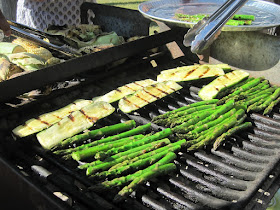Perfect ripe apricots are splendid, like these beauties that I photographed on the deck of our apartment here in Santa Barbara. The flavor is unimaginably wonderful. I don't see them often -- not even every year, as they don't travel well.
I think this year's apricot crop is exceptional even for California -- they've been available at an incredible price each time I have gone to the Santa Barbara Farmers' Market. We have been eating them every day since our arrival -- we hadn't been here more than a few hours before our first visit to the Sunday market in Goleta. Yesterday I went to the very large downtown Santa Barbara market (more photos here).
I have only a few memories of apricots. As a child, I loved dried apricots and even canned apricots, but I do not think I ever saw fresh ones until we lived in California during graduate school. And of course I realized that the taste of a ripe apricot like the ones we have been enjoying is just not the same as any other taste.
Sometimes Michigan trees produce a small apricot crops, and sometimes there are baskets of apricots from California in specialty markets at home in Ann Arbor. Several years ago when they were in season, I found a great apricot cobbler recipe, which I remember making for Evelyn and Tom just after Miriam was born -- her birthday was last week, so obviously they were in season when I was there to see my first grandchild.
Once during our first time in California I made an apricot tart -- I must have used a Julia Child recipe, as I didn't have very many cookbooks then. The old oven in our Berkeley apartment was very dirty. Black flakes fell on the apricots before the tart was finished baking, but I removed them and we enjoyed eating it. The next day, I cleaned the oven with oven cleaner -- it took hours. Evelyn was born the day after that. Some people told me that the impulse to clean was a sign that I was ready to give birth. I think I cleaned the oven just because of black carbon flakes on my beautiful apricot tart.
Update: Elaine remembers -- My California apricot remembrance: When Dan was a baby we carefully followed Dr Spock's recommendations and peeled grapes for him and otherwise watched what he ate. When he was less than a year old, he was crawling around in our back yard, found a lovely ripe apricot that had fallen from our tree, and ate most of it before I noticed. No ill effects! This convinced me that I didn't have to monitor his food so carefully. You are right that fresh California apricots are wonderful.




